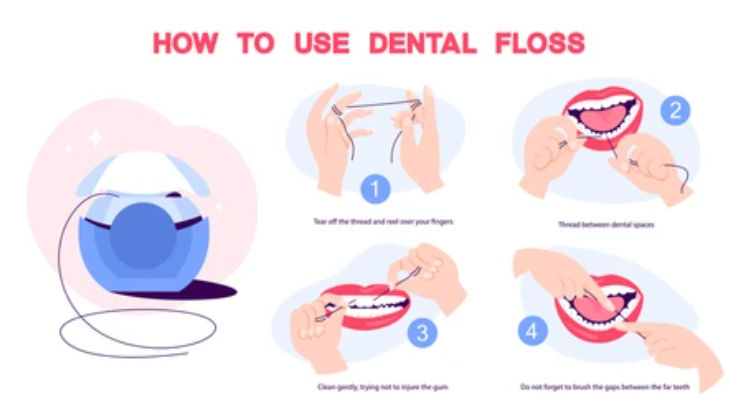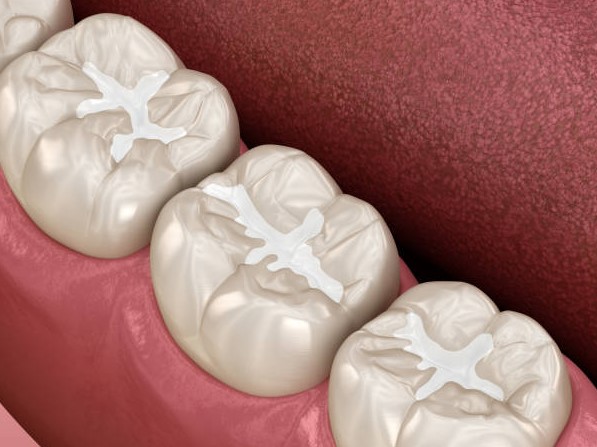What is Flossing?
Flossing is a dental hygiene practice that involves using a thin, nylon filament called dental floss to remove food particles and plaque from between the teeth and along the gumline. Flossing helps to prevent tooth decay and gum disease by removing bacteria and other debris that can accumulate in hard-to-reach areas of the mouth that a toothbrush may not be able to reach.
To floss, a length of dental floss is wrapped around the fingers of each hand, and then guided gently between the teeth using a sawing motion. The floss is then curved into a C-shape against one tooth, and then slid gently up and down into the space between the tooth and the gumline. This process is repeated for each tooth, using a clean section of floss for each tooth to avoid transferring bacteria from one area to another.
Flossing is an important part of a daily oral hygiene routine, along with brushing teeth twice a day, and regular dental check-ups. Regular flossing can help to prevent gum disease, tooth decay, and bad breath, as well as promote overall oral health.
Flossing for healthy gums is the process of using dental floss to remove food particles and plaque from between the teeth and along the gumline. Flossing is an important part of maintaining good oral hygiene and preventing gum disease.
To floss properly, take a piece of dental floss about 18 inches long and wrap the ends around your fingers. Gently guide the floss between your teeth, using a back-and-forth motion. Be careful not to snap the floss into your gums, which can cause bleeding and irritation. When you reach the gumline, curve the floss into a C-shape against one tooth and gently slide it into the space between the gum and the tooth. Repeat this process for all of your teeth, using a fresh section of floss for each tooth.
Flossing should be done at least once a day, preferably before brushing your teeth. It is important to use proper technique and to be gentle to avoid causing damage to your gums. By incorporating flossing into your daily oral hygiene routine, you can help to prevent gum disease and maintain healthy gums.
The benefits of flossing for healthy gums
Flossing is an important part of oral hygiene and can have many benefits for healthy gums.
Here are some of the key benefits of flossing:
- Removes plaque: Flossing helps to remove plaque and food particles from between teeth and along the gumline where a toothbrush can’t reach. Plaque is a sticky film of bacteria that can lead to gum disease and tooth decay.
- Prevents gum disease: Gum disease is caused by bacteria in plaque that can lead to inflammation and infection of the gums. Regular flossing can help to prevent gum disease by removing plaque and reducing the risk of inflammation.
- Reduces bad breath: Food particles and bacteria that are left between teeth can contribute to bad breath. Flossing can help to remove these particles and bacteria, reducing the risk of bad breath.
- Improves overall oral health: Flossing, along with brushing and regular dental check-ups, can help to improve overall oral health by reducing the risk of gum disease, tooth decay, and other oral health problems.
In summary, flossing is an important part of maintaining healthy gums and overall oral health. It can help to remove plaque, prevent gum disease, reduce bad breath, and improve overall oral health.
How To Use Dental Floss?
Using dental floss properly can be an effective way to remove plaque and food particles from between teeth and along the gumline. Here are the steps to use dental floss:
- Start with a piece of dental floss that is about 18 inches long. Wrap most of the floss around your middle fingers, leaving about 1-2 inches to work with.
- Hold the floss tightly between your thumbs and forefingers and guide it gently between your teeth, using a back-and-forth motion.
- When the floss reaches the gumline, curve it into a C-shape against one tooth and gently slide it into the space between the gum and the tooth.
- Hold the floss tightly against the tooth and gently rub the side of the tooth, moving the floss away from the gum with an up-and-down motion. Be gentle and avoid snapping the floss into the gum, which can cause bleeding and discomfort.
- Repeat this process for all of your teeth, using a fresh section of floss for each tooth. Unwind the floss from one hand and wind it onto the other hand as you go, so that you are always using a clean section of floss.
- After flossing, rinse your mouth with water to help remove any loosened debris.
Remember, flossing should be done at least once a day, preferably before brushing your teeth. It is important to use proper technique and to be gentle to avoid causing damage to your gums. By incorporating flossing into your daily oral hygiene routine, you can help to prevent gum disease and maintain healthy teeth and gums.




